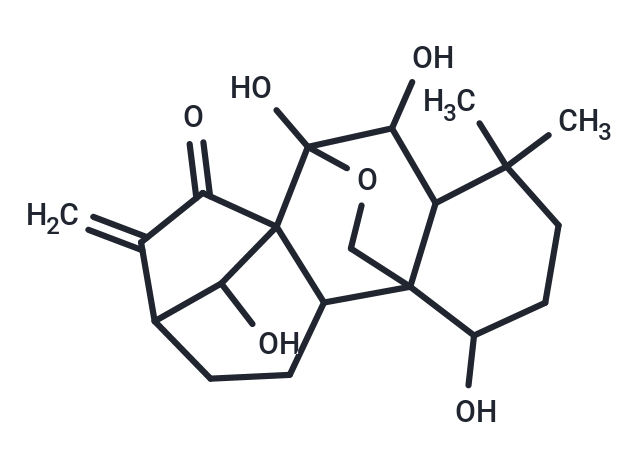Shopping Cart
Remove All Your shopping cart is currently empty
Your shopping cart is currently empty
Oridonin (NSC-250682) is a diterpenoid isolated from Rabdosia rubescens with anti-tumor, anti-bacterial and anti-inflammatory effects. It acts as an inhibitor of AKT, with IC50s of 8.4 and 8.9 μM for AKT1 and AKT2.

| Pack Size | Price | USA Warehouse | Global Warehouse | Quantity |
|---|---|---|---|---|
| 10 mg | $44 | In Stock | In Stock | |
| 25 mg | $65 | In Stock | In Stock | |
| 50 mg | $89 | In Stock | In Stock | |
| 100 mg | $143 | In Stock | In Stock | |
| 500 mg | $353 | - | In Stock | |
| 1 mL x 10 mM (in DMSO) | $48 | In Stock | In Stock |
| Description | Oridonin (NSC-250682) is a diterpenoid isolated from Rabdosia rubescens with anti-tumor, anti-bacterial and anti-inflammatory effects. It acts as an inhibitor of AKT, with IC50s of 8.4 and 8.9 μM for AKT1 and AKT2. |
| Targets&IC50 | Akt2:8.9 μM, Akt1:8.4μM |
| In vivo | LD50: Mice 35-40 mg/kg. [4] |
| Synonyms | Rubescensin A, Rubescenin, NSC-250682, Isodonol |
| Molecular Weight | 364.44 |
| Formula | C20H28O6 |
| Cas No. | 28957-04-2 |
| Smiles | CC1(C)CCC(O)C23COC(O)(C(O)C12)C12C(O)C(CCC31)C(=C)C2=O |
| Relative Density. | 1.42 g/cm3 |
| Storage | Powder: -20°C for 3 years | In solvent: -80°C for 1 year | Shipping with blue ice/Shipping at ambient temperature. | ||||||||||||||||||||||||||||||||||||||||
| Solubility Information | H2O: < 1 mg/mL (insoluble or slightly soluble) Ethanol: 28 mg/mL (76.83 mM), Sonication is recommended. DMSO: 65 mg/mL (178.36 mM), Sonication is recommended. | ||||||||||||||||||||||||||||||||||||||||
| In Vivo Formulation | 10% DMSO+40% PEG300+5% Tween 80+45% Saline: 2 mg/mL (5.49 mM), Sonication is recommended. Please add the solvents sequentially, clarifying the solution as much as possible before adding the next one. Dissolve by heating and/or sonication if necessary. Working solution is recommended to be prepared and used immediately. The formulation provided above is for reference purposes only. In vivo formulations may vary and should be modified based on specific experimental conditions. | ||||||||||||||||||||||||||||||||||||||||
Solution Preparation Table | |||||||||||||||||||||||||||||||||||||||||
Ethanol/DMSO
DMSO
| |||||||||||||||||||||||||||||||||||||||||
| Size | Quantity | Unit Price | Amount | Operation |
|---|

Copyright © 2015-2026 TargetMol Chemicals Inc. All Rights Reserved.